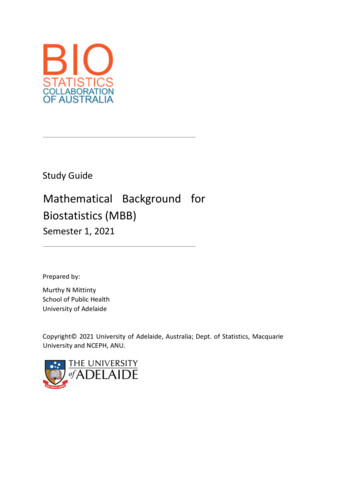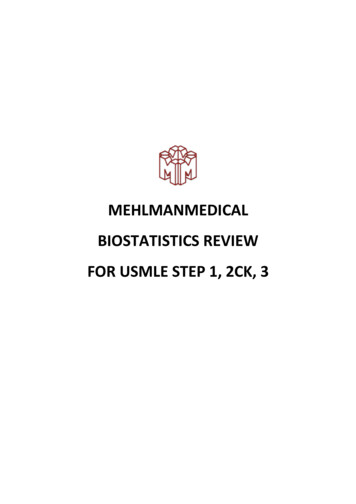
Transcription
MEHLMANMEDICALBIOSTATISTICS REVIEWFOR USMLE STEP 1, 2CK, 3
MEHLMANMEDICAL.COMBIOSTATISTICS QUESTIONS1. 62-year-old male comes to the office for a check-up. He has no significant past medical historyand currently feels fine. Last year his wife was diagnosed with adenocarcinoma of the colon. Heis interested in the screening programs for colon cancer. Which of the following features of atest makes it valuable as a screening tool:a) high specificityb) high positive predictive valuec) high sensitivityd) high accuracye) high precisionThe correct answer is c.The idea behind screening is to identify early cases of a disease. In order for a test to be avaluable screening test it needs to identify almost all individuals affected by a condition. Assuch, it is important that screening tests have the lowest possible false negative rate. The falsepositive rate is of lesser concern as individuals identified by screening tests can be furtherassessed by tests with higher specificity to confirm the diagnosis. Positive and negativepredicted value tell us what proportion of positive and negative tests are truepositives/negatives. Accurate tests are the ones that produce results that are close to the realvalue, while precise tests produce results that are close to each other.2. A large medical center has developed a biomarker that can be used for ALS screening. Theydecide to offer the test to all patients aged over 50. Subsequently, they determine that followingthe introduction of the test, survival of ALS patients has increased by approximately twomonths. Which of the following is a possible explanation of the finding:a) selection biasb) measurement biasc) length-time biasd) lead-time biase) confoundingThe correct answer is d.Lead-time bias refers to apparent survival increase due to earlier disease detection without anychange in disease course. ALS is an incurable disease with very limited treatment options. EarlyMEHLMANMEDICAL.COM 2
MEHLMANMEDICAL.COMtreatment would be unlikely to alter the disease course. Selection bias refers to nonrandomsampling of study participants. Measurement bias would be present if there was an issue withthe way a variable was measured (eg, faulty equipment). Length-time bias refers to thetendency of screening tests to detect diseases with longer latency periods (eg, the window inwhich a slowly-progressive lymphoma that may have a latency period of a many years can bediagnosed is far larger than the one for rapidly-progressive lymphomas). Confounders areexternal variables that may affect the outcome. For example, if heroin users were more likely tobe alcoholics, it could be determined that alcoholic liver disease is more common among heroinusers and lead to the conclusion that heroin causes alcoholic liver disease.3. 62-year-old female with history of hypertension presents to her primary care physician’s officeto discuss her blood pressure management. For the past week, she has kept a blood pressurediary by measuring it at the same time each day. Her systolic blood pressure measurements (inmmHg) were: 145, 129, 140, 129, 129, 132, 145. Which of the following values represents hermedian systolic blood pressure over the past week:a) 145b) 132c) 140d) 136e) 129The correct answer is b.The median measurement is the one that has an equal number of measurements greater andlesser than it. In this case it is 132 as 3 of the measurements were 129, which is lower than 132and 3 measurements were 136, 140 and 145 all of which are larger than 132. In case there is aneven number of measurements, the median is the average of the two middle values. The mode isthe most frequently encountered value, which in this case is 129. The mean value is the sum ofall the measured values divided by the number of measurements:(145 129 140 129 129 132 145)/7 136.4. A case-control study examining the relationship between alcohol use and pancreatitisdevelopment generated the following data:Alcohol users who developed pancreatitis: 60; alcohol users who did not develop pancreatitis30, alcohol non-users who developed pancreatitis: 40; alcohol non-users who did not developpancreatitis: 70. Which of the following represents the way odds ratio is calculated:a) (60*40)/(70*30)MEHLMANMEDICAL.COM 3
MEHLMANMEDICAL.COMb) (60*30)/(70*40)c) (60*70)/(40*30)d) (60*70)/(60*30*40*70)e) cannot be determinedThe correct answer is c.The odds ratio represents the odds that a person affected by a condition was exposed to a riskfactor (odds 1) versus the odds that a person unaffected by the same condition was exposed tothe same risk factor (odds 2). It is calculated as odds 1/odds 2. Odds 1 60/40; odds 2 30/70.A simple calculation gives us the OR (60*70)/(40*30).5. An epidemiology graduate student has chosen to write her PhD thesis in epidemiology on thetopic of disease prevalence and incidence. For the purposes of the study, she is required to picka disease with an approximately equal prevalence and incidence. Which of the followingdiseases best satisfies the requirement:a) Streptococcal pharyngitisb) Aortic stenosisc) HIVd) Schizophreniae) Carpal tunnel syndromeThe correct answer is a.Disease prevalence refers to the number of people affected by the condition, while diseaseincidence refers to the number of newly diagnosed cases. Therefore, in order for those twovalues to be close to each other, it is essential that the disease duration is short. Almost allpatients recover from Streptococcal pharyngitis in the same year they develop the disease,making the prevalence and incidence very closely aligned. Schizophrenia, carpal tunnelsyndrome, aortic stenosis and HIV are all chronic conditions and once patients are diagnosedthey generally remain affected for life (unless, for example, carpal tunnel syndrome is treatedsurgically). While incidence of those conditions may remain stable, with each passing year, theprevalence of the disease increases as previously diagnosed patients remain affected and newcases are diagnosed.6. 68-year-old female has been diagnosed with pneumonia caused by the newly describedcoronavirus. Having watched the news, she is extremely worried about dying from the diseaseMEHLMANMEDICAL.COM 4
MEHLMANMEDICAL.COMand asks the physician how likely she is to survive the disease. Which of the following terms isshe most interested in:a) number needed to treatb) number needed to harmc) attributable riskd) case fatality ratee) relative riskThe correct answer is d.Case fatality rate is the percentage of patients who die from the disease among those who havebeen affected. Considering that the patient wants to know how likely she is to survive thecondition, the most valuable piece of information is the percentage of patients affected who endup dying, which is the case fatality rate. Relative risk is the risk of developing a disease amongpatients exposed to a risk factor divided by the risk in the unexposed (eg, it tells us that smokersare a certain number of times more likely to develop lung cancer compared to non-smokers).Attributable risk is the difference in risk between the two groups. Number needed to treat andnumber needed to harm refer to the number of patients who need to receive an intervention inorder for 1 patient to be helped or harmed.7. The investigators are planning a decade-long research project on the association betweenchronic kidney disease (CKD) and long-term NSAID use. The participants have been dividedinto two groups based on whether they are on chronic NSAID therapy. They will be followedfor CKD development over the next ten years. This study can best be described as:a) Prospective cohort studyb) Retrospective cohort studyc) Case-control studyd) Cross-sectional studye) Clinical trialThe correct answer is a.The project described is a textbook example of a prospective cohort study, where participantsare divided into two groups based on their exposure to the risk factor and then followed for aperiod of time for development of an effect. In this case, the ultimate goal will be to determinethe relative risk of CKD development in patients taking NSAIDs. Retrospective cohort studiesare similar but their starting point is in the past. Their major advantage over prospective studiesis the significantly shorter timeframe required to complete the study. Clinical trials require anMEHLMANMEDICAL.COM 5
MEHLMANMEDICAL.COMactive intervention (eg, if NSAIDs were actively prescribed to protect from CKD, rather thangiven as a treatment for another condition). Neither cross-sectional nor case-control studiesinvolve following participants for a period of time.8. In a case control study, 200 patients with lung cancer were compared to 200 controls. Theywere asked about their smoking habits. The calculated odds ratio was 5.5; the 95% confidenceinterval was 3.2 to 7.8 for this association. Which of the following is the correct interpretationof these results:a) there is a 95% chance that the odds ratio is 5.5 and 5% chance that it is between 3.2 and 7.8b) at least 5% of smokers develop lung cancerc) 5% of smokers account for 7.8% of newly diagnosed lung cancersd) there is a 95% chance that the true value of the odds ratio is between 3.2 and 7.8e) there is on average a 5.5% increased risk for lung cancer among smokersThe correct answer is d.The confidence interval represents an interval where the true value most likely falls. There is a95% chance that the true value falls within the 95% confidence interval. In order for results tobe statistically significant, it is essential that it does not contain the value 1. In this case, theresults are statistically significant and there is a 95% chance that the true odds ratio fallsbetween 3.2 and 7.8.9. Researchers are looking for new biomarkers that can aid in diagnosing congestive heart failure(CHF) in the areas with a shortage of cardiologists, where obtaining echocardiograms may bedifficult. They have identified five different molecules and named them CHF1, CHF2, CHF3,CHF4, and CHF5. Their sensitivities and specificities were compared to findings onechocardiography, which is considered the gold standard. Which of the biomarkers would bethe most useful to confirm the diagnosis of CHF:a) CHF1 - sensitivity: 67%, specificity 72%b) CHF2 - sensitivity 95%, specificity 56%c) CHF3 - sensitivity 81%, specificity 81%d) CHF4 - sensitivity 50%, specificity 89%e) CHF5 - sensitivity 58%, specificity 93%The correct answer is e.MEHLMANMEDICAL.COM 6
MEHLMANMEDICAL.COMThe higher the specificity of the test, the better the test is for confirming the diagnosis. Incontrast, the higher the sensitivity of the test, the better it is as a screening test. The goal ofscreening is to identify all patients with the condition, even at the expense of getting a numberof false positive results. Confirmatory tests, on the other hand, are best when the rate of falsepositives is as low as possible, meaning that the patients who test positive very likely have thedisease.10. 25-year-old male presents to the office with fever and sore throat for the past 3 days. His pastmedical history is insignificant. The physician performs an exam and concludes thatstreptococcal pharyngitis is the most likely explanation of the patient’s symptoms. To confirmthe diagnosis, he decides to use a novel test which has a positive predictive value of 87%. Thepatient tests positive. Which of the following best explains the meaning of this finding:a) there is a 13% chance the patient has the diseaseb) there is a 13% chance the patient does not have the diseasec) the test is 87% accurate in diagnosing the diseased) the test is 87% specific for the diseasee) the test is 87% sensitive for the diseaseThe correct answer is b.The positive predictive value of a test is a probability that a person who tests positive indeedhas the condition. The test the physician in question used reportedly has a positive predictivevalue of 87%, meaning there is an 87% chance that the patient who tested positive has thedisease. That, in turn, means that there is a 13% chance that he does not have the disease.Accuracy of the test refers to the tests ability to yield results that are close to the real value.Sensitivity of the test is the probability that the test is positive when the disease is present, whilethe specificity is the probability that the test is negative when the disease is absent.11. A health department of a small island nation with a steady population and almost no migrationis writing the annual report on type II diabetes in the community. There are 12,000 peopleliving on the island, with 1,800 of them currently affected by the disease. 100 of them werediagnosed in the previous year. In the same year 80 patients with diabetes passed away. Whichof the following is the prevalence of the disease in the population:a) 100/1,800b) 100/12,000c) 1,800/12,000d) 20/1,800MEHLMANMEDICAL.COM 7
MEHLMANMEDICAL.COMe) 100/10,200The correct answer is c.The prevalence of a disease in the population tells us the percentage of the population that isaffected by a condition. It is calculating by dividing the number of existing cases with the totalnumber of people in the population. In this population 1,800 out of 12,000 people have type IIdiabetes. Therefore, the prevalence of the disease is 1,800/12,000. The incidence of the diseaselooks at the number of new cases (in this case 100) and is calculated by dividing that number bythe number of people at risk. The fact that 100 new cases of the disease were diagnosed and thatonly 80 patients passed away means that the prevalence of the disease is increasing even with asteady incidence, which is typical of many chronic diseases.12. A medical student is writing his first research paper. He is interested in finding out whetherthere is an association between acute pancreatitis and paracetamol use. He will be doing aretrospective cohort study and has already identified the patients that will be enrolled in thestudy. Which of the following is the c
BIOSTATISTICS QUESTIONS 1. 62-year-old male comes to the office for a check-up. He has no significant past medical history and currently feels fine. Last year his wife was diagnosed with adenocarcinoma of the colon. He is interested in the screening programs for colon cancer. Which of the following features of a

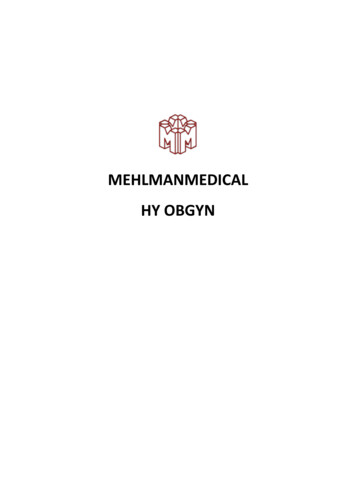
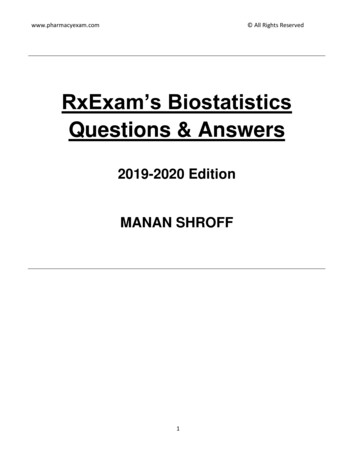
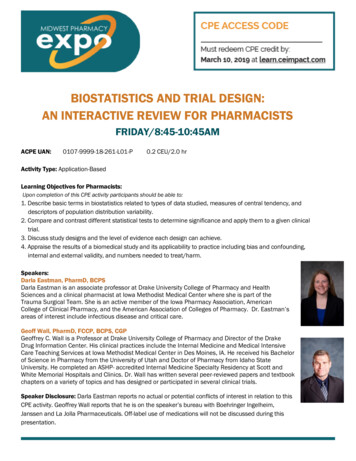
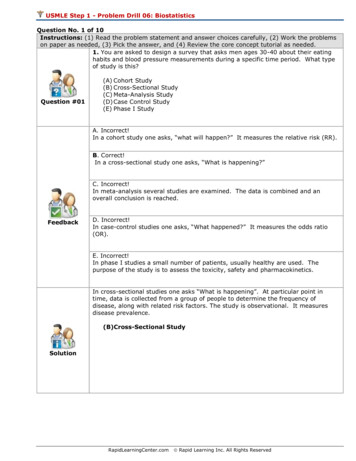
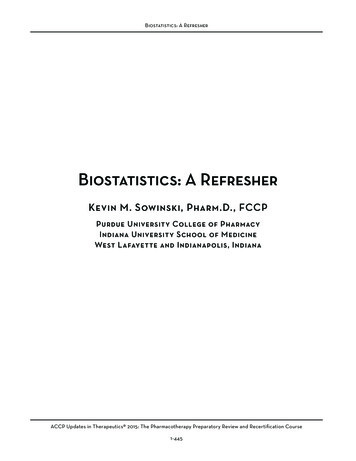
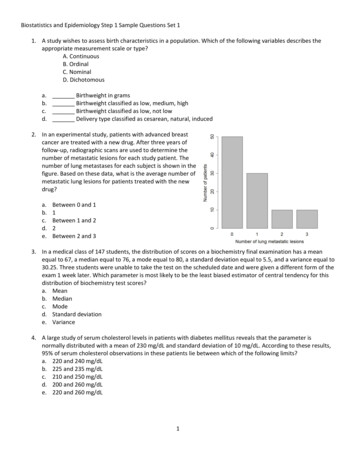
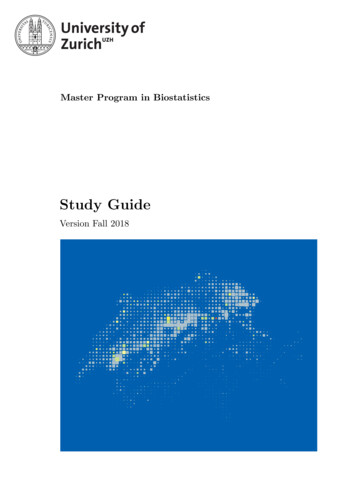
![Clinical Biostatistics [CLB]](/img/6/study-guide-clb-2021.jpg)
